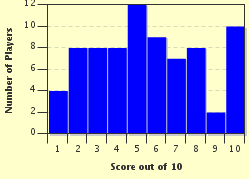Quiz Answer Key and Fun Facts
1. In the 8th century the Christianization of the Netherlands began in Frisia(Friesland). Willibrord was a monk, who started to convert the heathen Frisians and has been described as the "Apostle to the Frisians". He became the first Bishop of Utrecht. But where did he come from?
2. The most famous monk in Dutch history is Boniface. Boniface was an English monk, who was inspired by Willibrord. In the second half of the 8th century he started helping Willibrord converting the Frisians. However, many Frisians resisted the Christian missionaries. Saint Boniface was killed in 754. Where?
3. In 785 the Frankish armies conquered the last Frisian stronghold. The last Frisian king, Widukind, was baptized in Attigny. He was also adopted by the man who defeated him. Who conquered Frisia, adopted Widukind and converted the last "Dutch heathens"?
4. Charlemagne divided his empire into imperial palatinates ("Kaiserpfalzen"). These were imperial palaces with attached fiefdoms in Charlemagne's Empire. Each palace controlled a fief. The Netherlands were divided into three fiefdoms. Which cities had such imperial palaces?
5. The earliest written document in Dutch is "Hebban olla vogala". It was a medieval love song, probably written by a Flemish monk. Roughly when was it written?
6. The most famous Count of Holland was Floris V (1254-1296). He became count at the age of 2. His father William II died. How?
7. When Floris V became count, he wanted to avenge the death of his father. He attacked the Frisians, but the campaign was a great failure. While he was away fighting he almost lost his power. What happened?
8. Floris V was honoured by his ordinary subjects and hated by the nobles. In 1290 he was kidnapped by a few of his nobles who locked him up in his own castle. Which was it?
9. In the 14th century, many cities in the Netherlands started to flourish. Many of those cities were based on the river Ijssel. They started to trade with cities on the Baltic. Which of these was NOT part of the Hanseatic League?
10. Holland, especially Amsterdam, needed grain from the Baltic to feed the growing population. The Hanseatic League tried to protect their monopoly and demanded that Denmark should close the Sound to Dutch ships. Who won the four Dutch-Hanseatic wars?
Source: Author
Dcape5
This quiz was reviewed by FunTrivia editor
bloomsby before going online.
Any errors found in FunTrivia content are routinely corrected through our feedback system.
